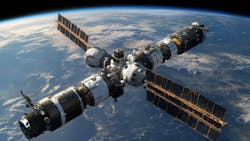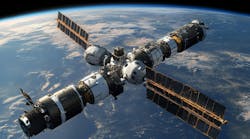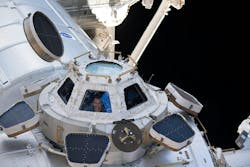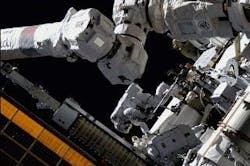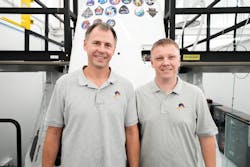ISS Power-Density Plans: Now and into the Future
What you’ll learn:
- The status of the International Space Station.
- The potential switch to commercial LEO destinations.
- Details on roll-out solar arrays (ROSAs).
After two decades, what is NASA planning to do after the present International Space Station (ISS) is decommissioned in about 2030?
The ISS is about the size of a professional football field. Its bigger modules as well as smaller components were delivered via 42 flights to complete the ISS assembly (37 on U.S. space shuttles and five on Russian Proton/Soyuz rockets).
In 2014, the ISS’s power generation consisted of eight solar arrays that provide an average of between 84 and 120 kW of power. However, a few of the solar arrays are more than 20 years old—they were originally designed for a 15-year service life. They’re now showing signs of degradation and are gradually getting less efficient over time. And the many complex science experiments being performed by the ISS astronauts are pushing the power requirements to the limit.
To keep up with the station’s power needs, the electrical systems on the ISS have continuously been upgraded. Excursions to the ISS in 2019 replaced batteries in the main systems. In 2022, new arrays needed to be added via a set of spacewalks.
In 2023, NASA astronauts installed roll-out solar arrays to enhance the existing eight main solar arrays. These added arrays will produce more than 20 kW of electricity, increasing power production by 30% over the ISS current arrays.
Then in 2024, NASA announced it had selected SpaceX to develop a "deorbit vehicle" to perform the task. The present space station will be deorbited in 2031.
International Space Station: The Future
Looking forward, NASA plans to transition the operations in low Earth orbit (LEO) to commercially owned and operated destinations to secure their continued access to indispensable research and technology development. In late August 2024, NASA received about 12 proposals for a new space station from quite a diverse group of companies. Estimates are that proposals came from such companies as Axiom Space, Bigelow Aerospace, Boeing, Lockheed Martin, and Space X.
>>Download the PDF of this article, and check out the Library Series for similar articles and videos
NASA seems to be interested in a commercial space station, as the present operating cost of the ISS is around $4 billion dollars each year. NASA would rather venture to the Moon again and then later to Mars. Thus, NASA plans to buy commercial space station services a la carte to save about $30 billion.
NASA has already begun awarding contracts worth hundreds of millions of dollars to companies that are able to develop new space stations. These possibly could turn into small research laboratories or even destinations for space tourists, maintaining humanity's presence in orbit around the Earth.
Axiom Space has been transporting paying astronauts on SpaceX rockets. In 2025, the company wants to begin attaching modules to the ISS. These may eventually be detached to form its own station that will be able to be rented out to paying customers.
Why Astronauts Need a New Space Station
A new space station must have updated research facilities with the latest, state-of-the-art laboratory equipment along with a much cleaner environment. Cabling and networking must be behind the panels so that it will be easier for lab technicians to easily move around in the space, maybe in LEO.
Most of the electronic components on the ISS are bulky. In the present ISS, there’s only one small inflatable module. That structure flies up, collapses, and later expands as it fills with air once attached to the primary structure of the station. It will literally blow up like a balloon. Astronauts are looking at multiple elements of a new space station becoming inflatable.
Axiom Space is developing a new space station with windows in the crew quarters—essentially an astronaut's window to the world. The ISS will also have a cupola that astronauts can pop their head and shoulders into and take in 360-degree views of space, in addition to being able to look down at the Earth. Actually, the cupola is so large that the astronauts can float their entire body in the area and have an experience like floating in space (Fig. 1).
What are Roll-Out Solar Arrays?
The latest technology for the new ISS solar arrays is a larger version of the roll-out solar array (ROSA).4,5
ROSAs provide an alternative to existing solar-array technologies. These compact arrays are far more affordable. They offer autonomous capabilities that will enhance a wide spectrum of scientific and commercial missions, beginning with LEO and ultimately leading to interplanetary travel.
The ROSA rolls up like a carpet to be stowed before launch, making it more easily transportable while maintaining a large surface area. In addition, ROSAs are scalable and modular as deployable space systems (DSS), created with a flexible design that would help to meet various mission requirements. ROSAs can also be scaled down for small satellite applications or made incredibly large for deep space missions.
Two NASA astronauts deployed the sixth, and possibly the last (on June 9, 2023), upgraded solar-array-mounted outside of the International Space Station. This increases the ISS's power-supply bank while tying an American spacewalk record (Fig. 2).
After 5 hours and 35 minutes, the spacewalk ended at 2:17 p.m. EDT as the re-pressurization of the Quest airlock began. Astronauts Nick Hague and Aleksandr Gorbunov performed this task (Fig. 3).
The next ISS is in the proposal stage right now. NASA’s Commercial LEO Development Program is planning to support the development of commercially owned and operated LEO destinations, from which NASA, together with other customers, will be able to purchase services and stimulate the growth of commercial activities in LEO.
As commercial LEO destinations (CLDs) become available, NASA plans to implement an orderly transition from the current ISS operations to these new CLDs.
A Commercial Turn to the Next ISS
The ISS, launched in 1998, will extend to 2030. The present ISS has a complete power system that generates 100 kW power (30 kW available for research activities). Volumetric power density is approximately 3,300 kW/m3. The total estimated volume needed for the ISS is about 0.022 to 0.027 m3.
Shifting of LEO operations to the private sector will enable efficiencies in the long term, enabling NASA to shift resources toward other key objectives. With the introduction of CLDs, NASA should gain efficiencies from the use of smaller, more modern and efficient platforms as well as achieve a necessary commercial approach to meet the agency’s needs in LEO.
References
1. “What will replace the International Space Station?,” May 15, 2023, Jonathan O'Callaghan, BBC.
2. “The International Space Station retires soon. NASA won't run its future replacement,” February 21, 2024, NPR, Space.
3. Cupola - NASA, Expedition 22, 2010.
4. “Impact Story: Roll-Out Solar Arrays,” NASA, May 23, 2024.
5. “Astronauts unfurl final roll-out solar array (for now) at space station in record-tying spacewalk,” Robert Z. Pearlman, SPACE.com, June 15, 2023.
6. “The International Space Station Transition Plan,” July 18, 2024.
7. “NASA’s SpaceX Crew-9 Crewmates to Head to Kennedy Ahead of Launch,” September 19, 2024.
8. “Fuel Cell Usage in the International Space Station,” Nathan Burklund, Geordan Chapman, Raphael Chutuape, Zhanzequn Yuan, University of Illinois at Urbana-Champaign, 2018.
>>Download the PDF of this article, and check out the Library Series for similar articles and videos
About the Author

Steve Taranovich
Freelance Technical Writer, Phoenix Information Communication LLC
Steve is a contributing editor to Electronic Design.
Author of the non-fiction “Guardians of the Right Stuff,” a true story of the Apollo program as told by NASA and Grumman Corp. engineers, an astronaut, and technicians.
Experienced Editor-In-Chief of EETimes/Planet Analog and Senior Technical Editor at EDN running the Analog and Power Management Design Centers from 2012 to 2019.
A demonstrated history in electronic circuit design and applications for 40 years, and nine years of technical writing and editing in industry. Skilled in Analog Electronics, Space-related Electronics, Audio, RF & Communications, Power Management, Electrical Engineering, and Integrated Circuits (IC).
1972 to 1988 worked as a circuit design engineer in audio (8 years) and microwave (8 years). Then was Corporate Account Manager/applications engineer for Burr-Brown from 1988 to 2000 when TI purchased Burr-Brown. Worked for TI from 2000 to 2011.
Strong media and communication professional with a BEEE from NYU Engineering in 1972 and an MSEE from Polytechnic University in 1989. Senior Lifetime member of IEEE. Former IEEE Long Island, NY Director of Educational Activities. Eta Kappa Nu EE honor society member since 1970.
